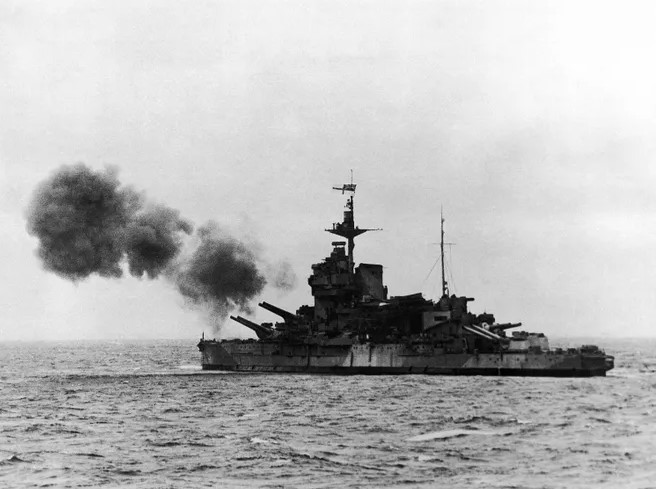On June 6, 1944, The Arizona Republic printed the headline in big, bold letters across the front page: “Allied Armies Invade French Channel Coast.”
It was another story in The Republic’s wall-to-wall coverage of World War II, but the significance of D-Day wasn’t lost on Phoenix residents on that day in 1944. A glimpse into The Republic’s archives and those of the now-defunct Phoenix Gazette paint a picture of what life was like during the war and what D-Day meant to the Valley.
In a June 7, 1944 story, a Republic writer noted that Americans received news of the invasion “calmly, with little jubilation,” worried that their relatives might be involved in the effort. The American, Canadian and British D-Day forces numbered more than 5,000 ships, 11,000 airplanes and 150,000 soldiers.
The same story said people in the United States and around the world held hope that the D-Day invasion would not only be successful but would bring “an early end to the war in Europe.”
That optimism is reflected in a Republic ad from June 8, 1944, advertising a D-Day dance where violinist Al Donahue would “invade” the Shrine Auditorium with his song “Low Down Rhythm in a Top Hat.”
A Republic editorial cartoon from June 7, 1944, forecast success. Three lightning strikes equipped with swords bear down on a terrified Adolf Hitler who stands on a piece of land labeled “Europe.”
The artist, Reg Manning, would later win a Pulitzer Prize for an editorial cartoon he drew during the Korean War.
News of invasion brings relief

An attack like D-Day wasn’t unexpected, said Volker Benkert, an assistant Arizona State University professor of history who focuses on Germany and Europe. He said the buildup of American troops in Great Britain was no secret, and people were relieved to hear the invasion was happening.
World War II veteran Rex Prisbrey, 97, remembers feeling that relief. Now a resident of Belmont Village Senior Living Scottsdale, Prisbrey flew 95 combat missions as a B-24 pilot in the China Burma India Theater during the war.
“D-Day was on all of our minds, even though I was in the opposite part of the world,” Prisbrey said. “We kept our ear to the ground to listen to Churchill and Roosevelt and everything that was going on.”
Prisbrey said D-Day encouraged him and his fellow troops because they thought help was headed their way next.
To keep spirits up, President Franklin D. Roosevelt addressed the country that evening in the form of a prayer, and his famous radio address got front-page coverage from both The Republic and the Gazette. His address looked to reassure and inform Americans, as well as prepare them for future sacrifices, Benkert said.
“That’s something that the nation rallies behind and so did Arizona,” Benkert said.
Sacrifice at home, a boost to Phoenix
Arizonans supported the war effort in many ways, including war bonds, which got their fair share of newspaper advertising. A war bond ad from June 6, 1944, reminds readers to back troops with more war bonds because “Invasion costs money!”
Rationing also affected Arizonans and the companies they enjoyed. A Dreft soap ad from June 11, 1944, bemoans the inability to purchase the product because its ingredients were being used in the war effort.
“Special materials used in making Dreft are urgently needed by Uncle Sam,” the ad read. “Of course we are glad to cooperate — glad to lend every aid to today’s big effort. That is why Dreft very likely is not on your grocer’s shelves at present.”
The fact that D-Day was possible was a testimony to enormous industrialization and a move to a war-time economy on the home front, Benkert said.

“Arizona sees a particular benefit from that,” Benkert said. “It’s at this moment that industries are starting to gather in Arizona, and World War II is really a catalyst for industrialization in Phoenix, which until then was a really small town.”
Coverage of the time reflects bias and prejudice, too, and The Republic was no exception. Benkert said it’s important to recognize that white Americans were not the only ones to contribute to the Allied victory in World War II.
“(World War II) sees African Americans serving in a segregated army, sees Latino-Americans and combat Native Americans who contributed to this victory,” he said.
Like many newspapers at the time, the 1944 archives of The Republic and the Gazette contain racial slurs and racist cartoons woven throughout their wartime coverage.
Seventy-nine years later, the living veterans who contributed to this victory are dwindling. About 496,777 of the 16 million Americans who served were still alive as of September 2018, according to U.S. Department of Veterans Affairs statistics. Nearly 2,000 Arizonans died in service to the country during the war.
Arizona had 13,186 World War II living veterans as of September 2018.
Belmont Village Senior Living Scottsdale resident Gene Graham, 94, is one of those veterans. A colonel in the Air Force, he also served in the Korean and Vietnam Wars. Graham said it was important to continue to commemorate World War II and D-Day.
“It was a war of the world — not like a civil war like we had here,” he said. “We got rid of a couple bad seeds and of all of the guys who worked for them. It was one of the last wars that people didn’t object to. Think of what would have been the alternative.”
To read full article, click here.

